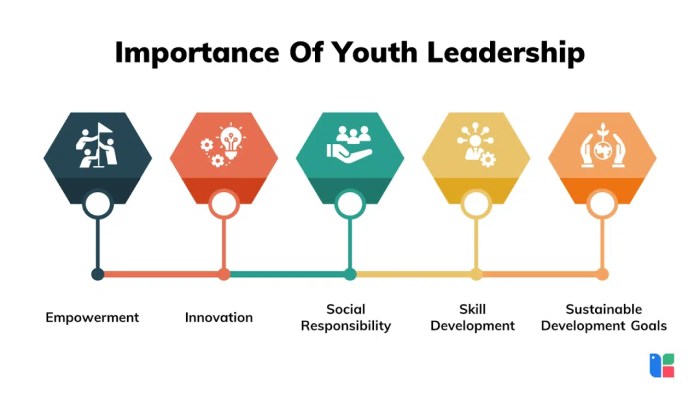10 leadership tips for the young generation provide a roadmap for navigating the complexities of leadership in today’s world. From understanding the nuances of modern leadership to building strong relationships and inspiring others, this guide offers practical advice for young individuals eager to make a positive impact.
This comprehensive guide delves into crucial aspects of leadership, including essential qualities, effective communication strategies, decision-making processes, and building trust and relationships. It also explores adaptability and resilience in dynamic environments, the importance of inspiring others, and the role of leadership in the digital age.
Introduction to Leadership for Young People
Leadership, in its essence, is the ability to inspire and guide others towards a common goal. It’s about influencing individuals to achieve something beyond their individual capabilities, fostering collaboration, and driving positive change. For young people, leadership isn’t just about holding a title or position; it’s about demonstrating values, taking initiative, and empowering others to achieve their full potential.
It’s about making a difference in the world, big or small.Effective leadership isn’t a fixed trait, but a set of skills and behaviors that can be learned and honed. It requires empathy, communication, and a clear vision. By understanding the principles of leadership, young people can leverage their talents to create positive change within their communities and beyond.
Examples of Effective Youth Leadership
Young people are demonstrating exceptional leadership across various fields. Greta Thunberg, a teenage climate activist, inspired millions globally with her powerful advocacy. Malala Yousafzai, another young leader, championed girls’ education rights, facing significant adversity. These examples highlight the potential of young people to drive social change. Further examples include student activists advocating for school reforms, young entrepreneurs building innovative businesses, and community organizers working to improve local conditions.
These individuals demonstrate the importance of young people stepping up and taking charge, regardless of their background or age.
Importance of Leadership for Positive Societal Impact
Leadership plays a crucial role in shaping a positive future. Young leaders can bring fresh perspectives, innovative ideas, and a strong commitment to social justice. They can bridge divides, promote inclusivity, and advocate for positive change in their communities. By developing leadership skills, young people empower themselves to contribute meaningfully to society, creating a better world for themselves and future generations.
Their active participation in shaping a more just and sustainable future is essential.
Comparison of Traditional and Modern Leadership Styles
This table highlights key differences between traditional and modern leadership styles, focusing on how they manifest in the young generation. The differences are not absolute, but rather represent a spectrum of approaches.
| Characteristic | Traditional Leadership | Modern Leadership | Youth-Focused Modern Leadership |
|---|---|---|---|
| Decision-Making | Top-down, hierarchical | Collaborative, participative | Decentralized, empowering |
| Communication | Formal, one-way | Open, transparent, two-way | Authentic, inclusive, empathetic |
| Power | Positional, authoritative | Relational, influence-based | Servant, empowering others |
| Focus | Compliance, efficiency | Innovation, adaptability | Purpose, social impact |
Essential Qualities of a Leader
Leadership is a multifaceted skill, crucial for navigating the complexities of any environment. For young people entering the professional world, developing strong leadership qualities is not just desirable; it’s essential for success. Effective leadership involves more than just authority; it necessitates a deep understanding of oneself and others, coupled with a commitment to growth and innovation.The key to effective leadership lies in identifying and nurturing the essential qualities that define a strong leader.
Young individuals possess unique advantages, including adaptability, technological fluency, and a willingness to embrace change. However, they often need to cultivate the foundational qualities that underpin successful leadership, such as communication, empathy, and decisiveness. These skills, while vital for all generations, often require specific strategies for young adults to develop and implement effectively.
Core Qualities for Effective Leadership
Cultivating a strong leadership presence requires recognizing and developing fundamental qualities. These are not inherent traits but skills that can be learned and honed through consistent effort and self-reflection. Young leaders, in particular, can leverage their natural enthusiasm and adaptability to develop these qualities to a high degree.
- Integrity: Acting with honesty and ethical principles is paramount. Young leaders who demonstrate integrity inspire trust and respect, crucial elements for building strong teams and achieving shared goals. For instance, a leader who upholds their word and consistently acts ethically fosters a positive and productive work environment.
- Communication Skills: Effective communication is the cornerstone of successful leadership. This encompasses active listening, clear articulation of ideas, and the ability to convey information in a way that resonates with diverse audiences. Developing strong communication skills allows young leaders to connect with team members, articulate visions, and build consensus.
- Empathy: Understanding and sharing the feelings of others is essential for building rapport and fostering collaboration. Empathetic leaders are better equipped to motivate and support their teams, creating a more inclusive and supportive environment. This includes recognizing and addressing the needs of individual team members, demonstrating genuine concern for their well-being, and creating a sense of belonging.
- Decisiveness: Making timely and informed decisions is critical in leadership. Young leaders must develop the ability to analyze situations, weigh options, and make sound judgments. This involves developing a process for decision-making that balances intuition with data-driven insights. For instance, practicing critical thinking skills and understanding the potential consequences of decisions can strengthen this quality.
- Adaptability: The ability to adjust to changing circumstances and embrace new challenges is vital for success. Young leaders face a dynamic and rapidly evolving world. Developing adaptability through experience, continuous learning, and flexibility is essential to thrive in this environment.
Self-Awareness in Leadership for Young Individuals
Self-awareness is not just a desirable trait but a cornerstone of effective leadership. Understanding one’s strengths, weaknesses, values, and motivations allows young leaders to make informed decisions, build strong relationships, and manage their emotions effectively.Self-awareness enables young leaders to understand their leadership style, identify areas for improvement, and recognize the impact they have on others. It empowers them to be authentic and transparent, fostering trust and respect within their teams.
This self-awareness allows young leaders to adjust their approach as needed and recognize when to seek mentorship or guidance.
Comparing Leadership Qualities Across Generations
| Quality | Older Generations | Middle Generations | Young Generation |
|---|---|---|---|
| Communication Style | Often more direct and formal | More collaborative and indirect | More digitally-fluent and collaborative, using various channels |
| Decision-Making Process | Generally more hierarchical and top-down | More collaborative and consensus-based | More agile and data-driven, leveraging technology for quicker decision cycles |
| Work Style | Often more structured and traditional | More flexible and adaptable, embracing change | More fluid and collaborative, comfortable with remote work and flexible schedules |
| Motivational Drivers | Often driven by stability and security | Driven by work-life balance and impact | Driven by purpose, innovation, and impact |
Communication Strategies for Leaders
Effective communication is the cornerstone of successful leadership, particularly for young leaders navigating the complexities of today’s world. Clear and concise communication fosters trust, builds strong relationships, and inspires action within teams. Young leaders must master various communication strategies to motivate and guide their peers and subordinates effectively. This section delves into crucial communication techniques and emphasizes the importance of adaptability and clarity in leadership roles.Effective communication transcends simply conveying information.
It involves actively listening, understanding different perspectives, and tailoring your message to resonate with your audience. Young leaders must recognize that their communication style significantly impacts team dynamics and overall project success. This section explores these strategies in detail, providing practical examples and highlighting the importance of adapting communication to specific audiences.
Active Listening Techniques for Young Leaders
Active listening is a crucial component of effective communication. It involves more than just hearing words; it necessitates understanding the speaker’s message, both verbally and nonverbally. Young leaders who actively listen demonstrate respect and create a safe space for open dialogue. This fosters trust and enables better understanding of team members’ needs and concerns. Active listening helps in building stronger relationships and fostering a collaborative work environment.
Thinking about 10 leadership tips for the next generation? It’s a great topic, but consider this: returning home after years abroad can be surprisingly tricky. Understanding cultural shifts and readjusting to your old life is crucial, just like the leadership skills you’re building. For example, check out 10 things expats should know before returning home 3 for some insightful advice on navigating this transition.
Ultimately, both returning expats and young leaders need adaptability and a strong sense of self to succeed.
- Paying close attention: Focus fully on the speaker, minimizing distractions and maintaining eye contact. Avoid interrupting or formulating your response while the other person is speaking. This demonstrates genuine interest and respect.
- Asking clarifying questions: Asking thoughtful questions shows genuine interest in understanding the speaker’s perspective. Questions like “Can you elaborate on that?” or “What are your concerns?” encourage deeper engagement and promote a more thorough understanding.
- Summarizing and paraphrasing: Restating the speaker’s message in your own words helps confirm understanding and ensures that you’ve grasped the core of their communication. This shows you’ve been actively listening and allows the speaker to clarify any misinterpretations.
Adapting Communication Styles for Different Audiences
Effective leaders understand that one-size-fits-all communication strategies don’t work. The young generation is particularly diverse, with varying communication preferences and expectations. To connect effectively, young leaders need to adapt their communication styles to resonate with different personalities and backgrounds. Understanding the nuances of various communication styles, and tailoring your approach accordingly, enhances engagement and fosters positive relationships.
A thoughtful approach builds rapport and creates a more inclusive environment.
- Formal vs. Informal: Adjust the level of formality in your communication based on the context and audience. A formal presentation might require a more structured approach, while a casual team meeting might allow for more informal interactions. Consider the audience’s expectations and adjust your language and tone accordingly.
- Visual vs. Verbal: Recognize that some individuals respond better to visual aids, such as presentations or diagrams, while others prefer verbal explanations. Using a mix of communication methods enhances clarity and ensures your message reaches a broader range of learners.
- Direct vs. Indirect: Tailor your approach to the specific context. A direct approach might be suitable for conveying critical information, while an indirect approach might be more appropriate for delivering sensitive feedback. Understanding the subtleties of both communication styles allows for nuanced interactions.
Importance of Clear and Concise Communication
Clear and concise communication is paramount in leadership roles. It eliminates ambiguity, reduces misunderstandings, and ensures that messages are received and acted upon effectively. Young leaders should strive to communicate their ideas and expectations with clarity and conciseness, avoiding jargon or complex language that might confuse their team members. Precise communication ensures that everyone is on the same page, optimizing productivity and efficiency.
Communication Styles and Effectiveness
| Communication Style | Description | Effectiveness in Leadership | Suitability for Young Generation |
|---|---|---|---|
| Direct | Clear, straightforward communication; focuses on facts and results. | High; fosters accountability and clarity. | Generally effective, but can be perceived as abrupt if not delivered respectfully. |
| Indirect | Gentle, nuanced communication; focuses on relationships and empathy. | Moderate; builds trust and understanding but can be perceived as vague. | Can be well-received, as it prioritizes consideration of others’ perspectives. |
| Active Listening | Emphasizes understanding the speaker’s perspective. | High; fosters collaboration and trust. | Highly valued; demonstrates respect and genuine interest. |
| Empathetic | Connects with the speaker’s emotions and concerns. | High; builds rapport and encourages open communication. | Highly valued; shows understanding and respect. |
Decision-Making Processes for Young Leaders
Navigating the complexities of leadership, especially in the early stages of a career, often hinges on effective decision-making. Young leaders face unique challenges, from balancing competing priorities to understanding the nuances of different perspectives. This crucial skill, honed through practice and careful consideration, is essential for success in any field.
Critical Thinking in Decision-Making
Critical thinking is fundamental to sound decision-making. It involves objectively analyzing information, identifying biases, and evaluating potential consequences. Young leaders should actively question assumptions, seek diverse viewpoints, and approach problems with a systematic, logical process. This ensures that decisions are well-informed and resilient to unforeseen circumstances.
Problem-Solving Approaches for Young Leaders
Various problem-solving approaches can enhance a young leader’s decision-making effectiveness. Understanding these methods allows for adaptability and tailored strategies. These approaches include: brainstorming, root cause analysis, and the scientific method. Each technique offers a structured framework for dissecting issues, generating potential solutions, and evaluating their feasibility. For instance, brainstorming encourages a wide range of ideas, while root cause analysis delves deeper to identify the underlying reasons behind a problem.
Considering Diverse Perspectives
Acknowledging and incorporating diverse perspectives is vital for young leaders. This encompasses understanding and respecting differing viewpoints, experiences, and backgrounds. By actively seeking input from a variety of sources, young leaders can gain a more comprehensive understanding of a situation and identify potential blind spots. This inclusive approach leads to more creative and well-rounded decisions.
Decision-Making Models for Young Leaders
Different decision-making models provide varying structures and frameworks. The rational model, for example, emphasizes careful analysis and objective evaluation. Conversely, the intuitive model relies on gut feelings and experience. The advantages of the rational model lie in its systematic approach, leading to potentially more calculated outcomes. However, the intuitive model can be quicker and more effective in certain situations.
Understanding the strengths and limitations of each model allows young leaders to choose the most appropriate method for the specific context.
Overcoming Decision-Making Obstacles
Young leaders may encounter various obstacles, such as fear of failure, indecisiveness, or external pressures. Overcoming these hurdles requires self-awareness, resilience, and a willingness to learn from mistakes. Seeking mentorship and feedback from trusted advisors can also provide valuable guidance. By acknowledging these challenges, young leaders can develop strategies to address them effectively.
Step-by-Step Decision-Making Process
A robust decision-making process empowers young leaders to approach choices with clarity and confidence. This structured approach is crucial for navigating complex scenarios.
| Step | Action | Explanation | Example |
|---|---|---|---|
| 1 | Define the problem clearly. | Precisely identify the issue at hand. | “Increase sales by 15% in Q3.” |
| 2 | Gather relevant information. | Collect data and insights from various sources. | Market research, sales figures, competitor analysis. |
| 3 | Generate potential solutions. | Brainstorm multiple options. | New marketing campaigns, price adjustments, product improvements. |
| 4 | Evaluate the solutions. | Assess the pros and cons of each option. | Cost-benefit analysis, feasibility, potential risks. |
| 5 | Select the best solution. | Choose the most suitable option based on evaluation. | Implement a new social media campaign. |
| 6 | Implement the solution. | Put the chosen plan into action. | Launch the campaign, track progress, and make necessary adjustments. |
| 7 | Monitor and evaluate the results. | Track the outcomes and make necessary adjustments. | Measure sales increase, gather customer feedback. |
Building Trust and Relationships

Building trust and strong relationships with team members is paramount for young leaders. It’s not just about getting things done; it’s about fostering a supportive environment where everyone feels valued and empowered to contribute their best. Trust and collaboration are essential for effective teamwork, driving innovation, and achieving shared goals. Young leaders who prioritize these elements cultivate a positive and productive work culture, setting the stage for sustainable success.Effective leaders understand that trust is earned, not demanded.
It’s a process that requires consistent effort, empathy, and a genuine interest in the well-being of team members. This foundation of trust allows for open communication, constructive feedback, and a shared commitment to achieving collective objectives.
Significance of Trust and Relationships
Trust and strong relationships are the cornerstones of a successful team. They create a safe space for open communication, enabling team members to share ideas, concerns, and feedback freely. This fosters a sense of belonging and shared purpose, driving increased motivation and productivity. A strong team dynamic is characterized by respect, empathy, and the willingness to support one another.
This mutual support is crucial for tackling challenges, adapting to change, and achieving exceptional results.
Strategies for Fostering Collaboration and Teamwork
Creating a collaborative environment requires actively promoting teamwork and open communication. Encouraging team members to share ideas and perspectives, even when differing, is key. This can be facilitated by regular team meetings, brainstorming sessions, and opportunities for informal interaction. Leaders should actively listen to team members’ input and provide constructive feedback. Furthermore, clearly defined roles and responsibilities within the team contribute to a more efficient and organized workflow.
Motivating and Inspiring Team Members
Motivating and inspiring team members is crucial for achieving collective goals. Young leaders can inspire their teams by clearly articulating a shared vision and purpose. They should focus on recognizing and rewarding individual contributions, fostering a sense of accomplishment, and celebrating milestones. Leaders should also be mindful of individual motivations and tailor their approach to inspire each member effectively.
Understanding the unique needs and aspirations of each team member allows for more personalized and effective leadership.
Empathy and Active Listening
Empathy is essential for understanding and responding to the needs of team members. Leaders should actively listen to their team members, understanding their perspectives, and acknowledging their emotions. Active listening involves paying close attention not only to the words being spoken but also to the nonverbal cues and underlying feelings. This empathy allows for better understanding and strengthens relationships.
Communication Styles for Building Trust
Various communication styles can be employed to build trust and strong relationships. A clear and concise communication style, where expectations are clearly defined and feedback is provided constructively, is crucial. A collaborative communication style that values input from all members is equally important. Using inclusive language, promoting open dialogue, and actively seeking feedback from team members creates a positive and productive environment.
Approaches to Building Trust and Strong Relationships
| Approach | Description | Example | Impact |
|---|---|---|---|
| Active Listening | Paying close attention to both verbal and nonverbal cues. | Asking clarifying questions, summarizing what’s been said, and acknowledging feelings. | Demonstrates respect, fosters understanding, and builds trust. |
| Open Communication | Creating a safe space for sharing ideas and concerns. | Regular team meetings, brainstorming sessions, and one-on-one check-ins. | Encourages collaboration and transparency. |
| Empathetic Leadership | Understanding and responding to the needs of team members. | Acknowledging individual contributions, providing support during challenges, and showing genuine interest in team members’ well-being. | Creates a supportive and inclusive environment. |
| Recognition and Appreciation | Acknowledging and celebrating individual and team achievements. | Publicly acknowledging contributions, providing positive feedback, and offering rewards for outstanding performance. | Motivates team members, fosters a sense of belonging, and strengthens team cohesion. |
Adaptability and Resilience in Leadership
Navigating the complexities of today’s world demands adaptability and resilience from leaders, especially young ones. The ability to adjust to changing circumstances and bounce back from setbacks is crucial for success in any leadership role. This is particularly important for young leaders, who often face rapid changes and unprecedented challenges in their professional environments. They need to develop strategies to not only cope with these hurdles, but to thrive in the face of adversity.Leadership in the 21st century is not about rigid plans, but about flexible responses.
Young leaders must be prepared to pivot, re-evaluate, and learn from both successes and failures. Resilience, the capacity to recover quickly from difficulties, is just as important as adaptability. These qualities enable young leaders to not only survive, but to thrive in dynamic environments.
Importance of Adaptability and Resilience
Adaptability and resilience are fundamental to effective leadership, particularly for young leaders entering dynamic environments. These qualities enable leaders to navigate uncertainty, adjust to changing circumstances, and maintain composure during periods of rapid transformation. Adaptable leaders can effectively respond to unexpected situations, quickly changing priorities, and evolving technologies. Resilient leaders, on the other hand, can bounce back from setbacks and learn valuable lessons from failures, thereby strengthening their leadership abilities.
Strategies for Handling Challenges and Setbacks
Effective strategies for handling challenges and setbacks involve proactive problem-solving, seeking support from mentors and peers, and cultivating a growth mindset. These strategies are essential for young leaders to learn and grow. Young leaders should foster a mindset of continuous improvement and learning from both successes and failures.
So, I’ve been thinking about these 10 leadership tips for the young generation, and honestly, sometimes the little things can make a big difference. Like, for example, you’ve got to be presentable, right? That means keeping your personal space smelling fresh and clean, just like in nobody wants to have stinky feet 13 ways to keep shoe odor at bay.
And that translates directly to how you present yourself to others, and ultimately, impacts your leadership presence. These details matter in any leadership role, young or old. It’s all about projecting confidence, which is key to good leadership.
Overcoming Obstacles and Learning from Failures
To overcome obstacles, young leaders must first identify the problem, analyze its root causes, and develop creative solutions. Learning from failures is equally crucial. A crucial aspect of overcoming obstacles is acknowledging the failure and learning from it, without blaming oneself or others. Instead, use the experience to adapt and improve future strategies. For example, if a project falls short of expectations, analyze the reasons behind the shortfall, such as inadequate planning, lack of resources, or miscommunication.
This process allows for valuable lessons to be learned and incorporated into future endeavors.
Continuous Learning and Growth
Continuous learning and growth are essential for young leaders to stay ahead of the curve and adapt to evolving challenges. Leaders should seek opportunities to learn new skills, acquire knowledge, and expand their perspectives. Young leaders should actively engage in lifelong learning through courses, workshops, mentorship programs, or simply by seeking out new experiences. This approach allows for a deep understanding of new trends, ideas, and ways of working.
Reading industry publications, attending conferences, or engaging in online learning communities are all effective strategies.
Thinking about how to lead effectively? Ten leadership tips for the young generation are crucial for success. It’s not just about ambition; it’s about building a strong foundation. While some might dream of owning their own private island, like those mentioned in 10 places you can own island even youre not larry ellison , real leadership often involves empowering others and fostering a positive work environment.
Ultimately, these leadership tips are valuable tools for any young person seeking to achieve their goals.
Examples of Young Leaders Demonstrating Adaptability and Resilience
Many young leaders have demonstrated adaptability and resilience in their roles. For example, consider the young entrepreneur who started a business during a pandemic, adjusting their strategies to meet the evolving needs of their customers. Or the young manager who successfully led a team through a significant organizational restructuring, demonstrating flexibility and resilience in the face of change.
These examples showcase how adaptability and resilience are crucial for navigating the challenges of leadership.
Strategies for Adapting to Changing Circumstances and Maintaining Resilience
| Situation | Strategy | Action Steps | Outcome ||—|—|—|—|| Unexpected Project Delay | Proactive Planning | Identify alternative solutions, adjust timelines, communicate updates transparently. | Project completion with minimal disruption. || Negative Feedback | Constructive Criticism | Analyze feedback, identify areas for improvement, develop action plans for growth. | Improved performance and strengthened leadership. || Shifting Priorities | Prioritization & Delegation | Identify key tasks, prioritize based on importance, delegate responsibilities effectively.
| Enhanced efficiency and successful completion of all tasks. || Team Conflict | Active Mediation | Facilitate open communication, identify root causes, mediate conflict resolution. | Strengthened team dynamics and improved collaboration. |
Inspiring and Motivating Others

Inspiring and motivating others is a crucial leadership skill, especially for young leaders navigating the complexities of today’s world. Effective leaders understand that motivation isn’t a one-size-fits-all approach. Young leaders need to tailor their strategies to resonate with their team members, understanding the diverse motivations and aspirations of their generation. Creating a positive and supportive environment is key to unlocking the full potential of each team member.
Strategies for Inspiring and Motivating Others
Motivation and inspiration are deeply personal. A young leader can’t simply decree enthusiasm; they must understand and address the individual needs and desires within their team. Effective strategies often combine a focus on shared goals, personal growth, and recognition. Young leaders must understand that fostering a positive work environment is paramount for effective motivation and inspiration.
Fostering a Positive and Supportive Environment
Creating a positive and supportive environment is crucial for team members to feel valued and motivated. Open communication channels, active listening, and constructive feedback are vital components. Leaders must be approachable and readily available to address concerns and provide guidance. Celebrating successes, big and small, is a significant aspect of building a supportive team culture.
Recognizing and Appreciating Contributions
Recognition and appreciation are powerful motivators. Young leaders should actively seek opportunities to acknowledge the contributions of their team members. This could involve verbal praise, written thank-you notes, public acknowledgment, or even small rewards. Recognizing achievements, both big and small, demonstrates appreciation and reinforces positive behaviors. A simple “thank you” can go a long way in boosting morale.
Setting Clear Goals and Expectations
Setting clear, achievable goals and expectations is fundamental to motivating a team. Young leaders must ensure that goals are clearly defined, measurable, and relevant to the team’s overall objectives. Breaking down large goals into smaller, manageable tasks can make them feel less daunting and more attainable. Effective communication regarding expectations and consequences for not meeting them is essential for fostering a productive and motivated team.
Examples of Inspirational Leaders
Numerous leaders have inspired and motivated others throughout history. Nelson Mandela’s unwavering commitment to justice and equality inspired millions to fight for a more just world. Malala Yousafzai’s advocacy for girls’ education has motivated countless young people to pursue their dreams and make a difference. These examples highlight the power of passion, purpose, and perseverance in inspiring others.
Their actions and words have created lasting impacts on those around them.
Key Principles of Motivation and Inspiration
| Principle | Description | Application for Young Leaders | Examples |
|---|---|---|---|
| Shared Purpose | Understanding and aligning with a shared vision or goal. | Clearly define team objectives and ensure every member understands how their work contributes to the overall goal. | Team projects, volunteer work, shared challenges |
| Growth Mindset | Encouraging continuous learning and development. | Provide opportunities for skill development, mentorship, and constructive feedback. | Training sessions, workshops, knowledge sharing |
| Recognition & Appreciation | Acknowledging and valuing contributions. | Actively seek ways to appreciate and recognize team members’ efforts. | Verbal praise, public acknowledgment, rewards |
| Open Communication | Facilitating transparent and honest dialogue. | Create a safe space for open communication, feedback, and problem-solving. | Regular team meetings, one-on-one conversations |
Leadership in a Digital World
The digital age presents unprecedented opportunities and challenges for young leaders. Navigating the complexities of online communication, collaboration, and ethical considerations is crucial for success in today’s interconnected world. This evolving landscape demands a new set of skills and understanding, empowering young leaders to leverage technology effectively while maintaining integrity and building strong online communities.The digital realm offers young leaders unparalleled access to information, global networks, and diverse perspectives.
However, this same digital space is fraught with misinformation, cyberbullying, and the need for swift and ethical decision-making. Leaders must be adept at navigating these waters, using technology as a tool for positive impact and growth.
Leveraging Technology for Effective Communication and Collaboration
Technology facilitates instant communication and collaboration, enabling young leaders to connect with people across geographical boundaries. Utilizing various platforms, such as video conferencing, project management software, and instant messaging, streamlines workflows and fosters teamwork. This interconnectedness allows for the exchange of ideas, feedback, and knowledge in real-time.
Digital Literacy and Ethical Considerations for Young Leaders
Digital literacy is essential for young leaders. It encompasses not only technical proficiency but also the ability to critically evaluate online information, identify misinformation, and promote responsible digital citizenship. Ethical considerations are paramount in the digital world. Young leaders must prioritize data privacy, online safety, and ethical use of technology.
Building and Managing Online Communities, 10 leadership tips for the young generation
Building and managing online communities requires a strategic approach. Young leaders can cultivate these communities by fostering a sense of belonging, encouraging participation, and promoting respectful dialogue. Active listening, responding to concerns, and creating opportunities for collaboration are key elements in community management.
Digital Tools for Leadership Development
Numerous digital tools facilitate leadership development. Online courses, interactive simulations, and virtual mentorship programs offer opportunities for skill enhancement and knowledge acquisition. Platforms like LinkedIn and online forums provide valuable networking opportunities, enabling young leaders to connect with mentors and peers.
Benefits and Drawbacks of Technology in Leadership Roles
| Benefit | Drawback | Mitigation Strategy | Example |
|---|---|---|---|
| Enhanced Communication | Information Overload | Prioritize communication channels, set clear expectations, and use tools effectively. | Using project management software for team communication reduces email clutter and keeps everyone on the same page. |
| Global Collaboration | Security Risks | Implement strong security protocols, educate team members on cybersecurity best practices, and regularly update systems. | Using a secure VPN for remote access to company data protects sensitive information. |
| Accessibility to Information | Misinformation | Verify information sources, encourage critical thinking, and promote media literacy. | Fact-checking news before sharing and using multiple reliable sources to understand a topic. |
| Increased Efficiency | Distraction | Establish clear boundaries, manage time effectively, and create dedicated workspaces. | Scheduling specific times for online meetings and communication, and setting boundaries between work and personal time. |
Taking Action and Making an Impact: 10 Leadership Tips For The Young Generation
Young leaders are not just those who hold positions of authority; they are individuals who actively shape the world around them. Taking action and making a positive impact on society is a crucial aspect of leadership, especially for the younger generation. It’s about recognizing problems, finding solutions, and inspiring others to join the cause. This involves understanding the issues, identifying effective strategies, and committing to sustained effort.
Importance of Societal Impact
Taking action to address societal issues is vital for young leaders. It builds character, fosters empathy, and cultivates a sense of responsibility towards the community. By proactively engaging with challenges, young leaders demonstrate their commitment to making a difference, which resonates with others and fosters a culture of positive change. This engagement builds a strong foundation for future leadership roles.
Strategies for Identifying and Addressing Societal Issues
Understanding societal issues requires careful observation and analysis. Young leaders should actively listen to the voices of their communities, research existing challenges, and engage in critical thinking. Understanding the root causes of problems is crucial for developing effective solutions. They should seek diverse perspectives, considering the experiences and viewpoints of various groups. This can be achieved through attending community events, volunteering, and participating in discussions with diverse individuals.
Examples of Young Leaders
Numerous young leaders have made significant contributions to their communities. Malala Yousafzai, advocating for girls’ education, and Greta Thunberg, championing climate action, are prime examples of young people who have galvanized global movements. Their courage and commitment have inspired millions. Similarly, countless local young leaders have initiated initiatives addressing local issues, from environmental protection to poverty alleviation, showcasing the potential of youth to create positive change.
Giving Back to the Community
Giving back to the community is fundamental for young leaders. It instills a sense of belonging and fosters a spirit of service, which is a core principle of leadership. Through volunteering, mentorship, and community involvement, young leaders can cultivate empathy, build strong relationships, and foster a culture of compassion. This reciprocation of community support builds strong, positive networks.
Involving the Community in Leadership Initiatives
Engaging the community in leadership initiatives is essential for creating sustainable change. Young leaders should actively seek feedback, encourage participation, and involve diverse perspectives. This approach fosters ownership and responsibility, ensuring that the initiatives resonate with the needs of the community and are sustainable in the long term. Transparency and open communication are crucial to build trust and support.
Impactful Actions by Young Leaders
| Young Leader | Initiative | Impact | Strategies |
|---|---|---|---|
| Greta Thunberg | School Strikes for Climate | Global awareness of climate change | Public advocacy, social media |
| Malala Yousafzai | Advocacy for girls’ education | Increased access to education for girls | Public speaking, activism |
| [Local Example 1] | [Local Initiative 1] | [Local Impact 1] | [Local Strategies 1] |
| [Local Example 2] | [Local Initiative 2] | [Local Impact 2] | [Local Strategies 2] |
Summary
In conclusion, this exploration of 10 leadership tips for the young generation equips aspiring leaders with the knowledge and tools to thrive in any situation. By embracing these principles, young individuals can not only achieve personal success but also contribute meaningfully to society, leaving a lasting legacy.








